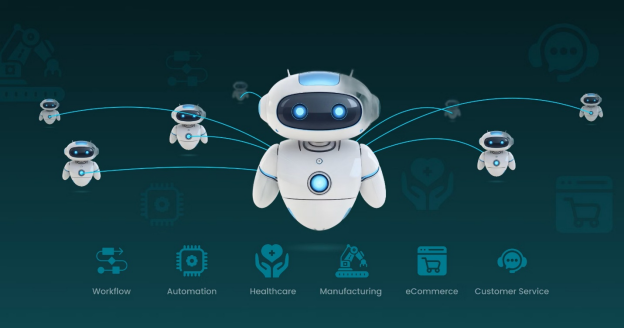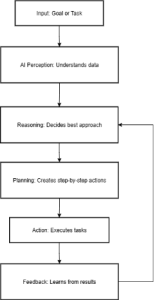AGENTIC AI

AGENTIC AI
Introduction
Artificial Intelligence (AI) has grown from being a simple tool into a smart system that can think, decide, and sometimes act on its own. A new step in this journey is called Agentic AI. Unlike traditional AI, which mainly gives answers or predictions, Agentic AI can make decisions, plan tasks, and take actions to achieve goals. In this article, we will explore what Agentic AI is, how it works, and why it matters.
What is AI?
Artificial Intelligence (AI) is the science of creating machines that can act like humans. It allows computers and systems to learn from data, recognize patterns, and make decisions. Common examples can be seen in voice assistants like Siri and Alexa, recommendation engines on Netflix or YouTube, and self-driving cars such as Tesla’s Autopilot system.
What Does “Agentic” Mean?
The word Agentic comes from “Agent,” which means something that acts independently. When we say something is agentic, it means it has the ability to act on its own, make choices, and achieve goals. In the context of AI, this means moving beyond simply following human instructions to becoming more autonomous and proactive.
What is an AI Agent?
An AI Agent is a system that can sense its environment, decide what actions to take, and learn from the outcomes. A self-driving car is a good example of an AI agent because it can see the road, decide when to turn or stop, and improve over time by learning from driving conditions. Similarly, financial robo-advisors that manage investments and adapt to market changes also act as AI agents.
What is Agentic AI?
Agentic AI is a form of artificial intelligence that does more than just respond to questions or predict outcomes. It can take actions on its own, much like an intelligent agent. Instead of waiting for constant human input, Agentic AI can plan steps to achieve goals, adapt to new situations, and complete tasks from start to finish. In simple words, it gives machines the power to act, not just react.
Core Capabilities of Agentic AI
Agentic AI is built on four main abilities. The first is perception, which allows it to understand its environment through text, images, or sensors. The second is reasoning, which means it can think through situations and decide on the best course of action. The third is planning, where the AI creates a sequence of steps to achieve a goal. Finally, it has the ability to take action, which allows it to carry out tasks on its own.
| Ability | Description | Example |
| Perception | Understands environment (text, images, sensors) | A robot “seeing” an object |
| Reasoning | Thinks and decides what to do | Deciding best delivery route |
| Planning | Makes a sequence of steps | Organizing a meeting automatically |
| Action | Performs tasks on its own | Booking tickets online |
The Lifecycle of an AI Agent
The lifecycle of an AI agent follows a repeating cycle. First, the agent senses its environment. Then it uses reasoning to make sense of what it has observed. After that, it plans the best way to achieve its goal. Finally, it takes action, and the results feed back into its learning. This cycle shows that Agentic AI is always improving by learning from its actions and adjusting to new situations.
Agentic AI vs. Traditional AI
Traditional AI is mainly designed to give answers or predictions when a human asks for them. It stays under full human control. In contrast, Agentic AI can act more independently. It does not just respond but can make plans and carry them out. For example, a chatbot answering FAQs is a traditional AI system, while an AI that schedules meetings by itself is agentic.
| Feature | Traditional AI | Agentic AI |
| Role | Answers questions, gives predictions | Plans, decides, and acts |
| Control | Human gives all instructions | AI can act with some independence |
| Learning | Learns from data only | Learns from data + environment feedback |
| Example | Chatbot answering FAQs | AI scheduling meetings by itself |
Applications of Agentic AI
Agentic AI is already being applied across multiple industries. In healthcare, systems like IBM Watson Health assist doctors with diagnosis and treatment planning. In finance, robo-advisors such as Betterment and AI-powered fraud detection systems are widely used. Education has seen the rise of personal AI tutors like the Duolingo AI tutor, which adapts to each learner’s style. Businesses benefit from AI assistants like Microsoft Copilot that can manage emails, reports, and scheduling. In transportation, Agentic AI powers self-driving cars such as Tesla Autopilot and delivery drones like Amazon Prime Air.
| Industry | Use Case | Example |
| Healthcare | AI agents helping doctors with diagnosis and treatment plans | IBM Watson Health |
| Finance | Automated trading and fraud detection | Betterment, robo-advisors |
| Education | Personal AI tutors guiding students | Duolingo AI Tutor |
| Business | AI assistants handling scheduling, emails, and reporting | Microsoft Copilot |
| Transport | Self-driving cars and delivery drones | Tesla Autopilot, Amazon Prime Air drones |
How Agentic AI Works?
The process of Agentic AI can be understood as a repeating cycle. It starts by receiving an input, such as a goal or a task. The system perceives and interprets the environment, reasons about the best approach, and then creates a plan by breaking the task into smaller steps. Once the plan is ready, it takes action and executes the steps. Finally, it learns from feedback and results, which improves its performance for future tasks.

Technologies Powering Agentic AI
Agentic AI is powered by different technologies. Machine learning helps it learn from data. Natural Language Processing (NLP) allows it to understand and communicate with humans. Reinforcement learning gives it the ability to learn from trial and error. Robotics helps it take physical actions in the real world. Finally, multi-agent systems allow multiple AI agents to work together.
| Technology | Role in Agentic AI |
| Machine Learning | Helps AI learn from data |
| Natural Language Processing (NLP) | Helps AI understand and talk with humans |
| Reinforcement Learning | Helps AI learn by trial and error |
| Robotics | Physical actions in the real world |
| Multi-Agent Systems | Multiple AIs working together |
Benefits of Agentic AI
Agentic AI brings many benefits. It allows automation, reducing repetitive human work. It increases efficiency by completing tasks faster and more accurately. It can provide personalization by learning individual user preferences. It is also highly scalable, meaning it can handle many tasks at the same time across large systems.
| Benefit | Explanation |
| Automation | Reduces repetitive human work |
| Efficiency | Finishes tasks faster |
| Personalization | Learns individual user preferences |
| Scalability | Can handle many tasks at once |
Risks and Ethical Considerations
Despite its benefits, Agentic AI also brings risks. One concern is job impact, as automation may replace certain roles. Another issue is bias, where AI may make unfair decisions if trained on biased data. Security is also a risk, since AI agents could be hacked or misused. Finally, autonomy itself can be a problem, as AI might make harmful decisions without human oversight.
The Future of Agentic AI
The future of Agentic AI looks promising. We may see smarter personal assistants that can fully manage our daily lives. Businesses could run with autonomous AI teams handling large parts of their operations. Transportation may become safer through advanced self-driving systems. Healthcare could benefit from AI agents that support doctors with complex cases. However, the success of these developments will depend on responsible use, proper regulation, and continuous human oversight.
Conclusion
Agentic AI represents the next major step in artificial intelligence. Unlike traditional AI, it can plan, decide, and act on its own. This creates opportunities for greater efficiency, personalization, and automation across industries. At the same time, it raises serious questions about ethics, security, and control. The challenge ahead is to ensure that Agentic AI works with humans, not against them, and is used responsibly for the good of society.
What is TechSurge.ai?
As we look at the future of Agentic AI, it is important to understand how companies are already building systems that can make this future real. One example is TechSurge.ai, an AI company that creates smart agents to help businesses work better.
At the core of TechSurge.ai are two main products:
- SurgeControl™this is the “manager” that connects different AI agents, plans their tasks, and keeps workflows running smoothly.
- SurgeTrust™this is the “safety system” that makes sure AI works in a safe, fair, and legal way by checking compliance rules, hiding private data, and keeping full records of what the AI does.
On top of this, TechSurge.ai provides more than 27 AI agents for real business tasks, such as sales, finance, support, HR, and analytics. Businesses can start small by using just one agent or choose a complete system of agents working together. This flexible design makes TechSurge.ai stand out compared to many other providers.
- Solving Real Business Problems
Many AI tools today can only give answers or predictions, but they do not finish the job. TechSurge.ai goes further by creating agents that take action, not just give advice. For example, the AI Invoicing Agent can send invoices and also track payments automatically, saving finance teams hours of manual work each week.
With SurgeControl™, agents follow a smart loop: sense → think → plan → act → learn. This means they keep improving over time, instead of staying static like many basic AI tools. TechSurge.ai also provides industry packs such as healthcare, finance, and legal, which are ready-made for real-world needs.
Businesses that use AI automation like invoicing and reporting can cut processing costs by up to 60% (Deloitte research). TechSurge.ai is designed to deliver this kind of measurable impact.
- Built-In Safety and Security
One of the biggest worries about AI is safety and compliance. Many providers leave this responsibility to customers, but TechSurge.ai builds it into the system from the start.
SurgeTrust™ makes sure every action follows rules like the EU AI Act and UK AI Act, so businesses can stay compliant with new laws. It also protects personal data through PII masking and creates audit logs so businesses can clearly see what the AI did. On top of this, TechSurge.ai provides Trust Receipts™, which act like proof slips for every action taken.
Data breaches cost companies an average of $4.45 million globally in 2023 (IBM report). By adding security at the core, TechSurge.ai helps reduce these risks dramatically.
- Flexible and Customer-Friendly Solutions
TechSurge.ai also stands out because it gives businesses real choices instead of one-size-fits-all tools. Companies can start with just one agent, such as an AI Recruitment Agent or AI Support Agent, or they can choose a complete AI system for larger automation.
The platform works for both small businesses, with affordable plans of £497–£997 per month, and for large enterprises, with £25k pilots that can scale to £100k+ per year. If errors happen, SurgeControl™ rollback makes it easy to undo or reset tasks without breaking the entire workflow.
The Agentic AI Manager provides a simple dashboard where businesses can monitor and manage all their agents. Most importantly, TechSurge.ai creates custom solutions based on customer needs, instead of forcing everyone into the same product.
Around 63% of small businesses say they struggle with AI tools that are too complex or inflexible (Salesforce SMB Trends Report). TechSurge.ai solves this by offering both simple single-agent solutions and scalable enterprise systems.
